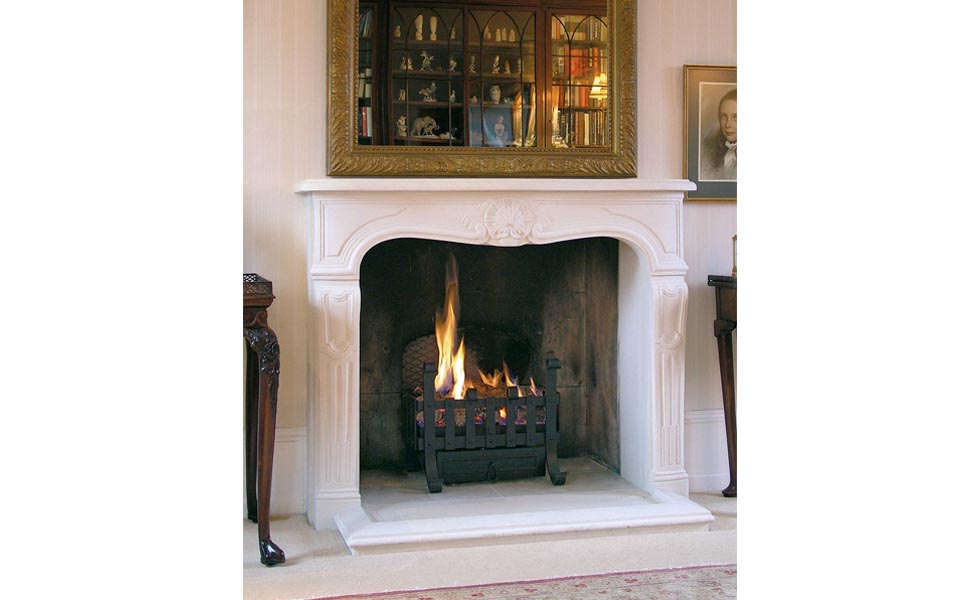

Whether you are installing a new fire or giving the existing one a makeover, choosing the right surround requires more consideration than just looks. Daisy Jeffery explains, and uncovers the latest models on the market

Depending on the style of your home, there are plenty of materials and styles of fire surround to suit all properties. Wood is the material of choice for country-style homes, and options are available from a wide range of manufacturers.
“Wood, being a softer medium, offers many possibilities in terms of design,” says Matt Beckenham of Stovax Heating Group. “It can also be stained or painted to your specific taste. From ornately modelled rich cherry to a more simple design offering painted warm white, a wooden mantelpiece can offset a traditional period fireplace or a modern gas appliance with equal aplomb.”

Percy Doughty’s Albero Oak surround, from the Penman Collection, features bold, clean lines for a sturdy appearance. POA
Brick surrounds with a timber mantle work well in country-style homes too.
If you are looking to specify a contemporary-style fire then stones such as marble, as well as brick and wood, are the materials of choice. However, many people choose to specify built-in or double-sided fireplaces for ultra-modern schemes.
If you live in a period or period-style property, it is worth researching surrounds typical of the era in which the house was built (or aspires to). Both Regency and Georgian properties for instance favoured ornate marble as well as stone surrounds.

The Regent 57” marble fireplace in Carrara marble from Capital Fireplaces wouldn’t look out of place in a period-style property. It includes a cast iron fascia, Provident highlighted fire frame with glass-fronted gas convector and a honed granite hearth. POA
“Stone has been a traditional material since the medieval times, while marble has been used for more than 300 years and continues to be a well-respected choice with its classic appeal and longevity,” says Matt Beckenham.
Wooden surrounds however were commonplace in Victorian homes, as was brick, and cast iron with its ability to diffuse heat was common during the Edwardian era.
In order to work out the size of fire surround you require, you will need to know the size of the appliance you intend to install; this will depend on the heat output required to warm the room.
“Homeowners looking for an appliance to heat up a particular area of the house should measure the proposed room first in order to find out the size of the appliance required,” explains Matt Forrester, Senior Design Engineer at Stovax Heating Group.
As a guide for every 14m³ (cubic metres) of space, you will need approximately 1kW of heat output in order to achieve a room temperature of 21°C. Note that the opening should not exceed nine times the area of the smallest part of the chimney/flue. Fire surround manufacturers/suppliers will generally offer widths between 55.5-61 inches and heights of around 42-52 inches. There are, however, companies offering bespoke measurements.

Elgin & Hall’s Odella inglenook surround (shown in the grey micro marble finish; also available in white and manila) features intricate detailing and a soft inward curve. POA
Like all aspects of the home, it is important to keep your fire surround clean, but the choice of material will determine how you maintain the look. If you have a marble surround for instance, washing the surface with soapy water and finishing with a wax polish will keep the marble in good condition.
Materials such as brick, slate and granite can be brushed to remove dirt, however if the surface is particularly marked, then a caustic cleaner can be used for brick and a liquid detergent for slate and granite.
Ceramic surrounds can be washed with hot water and diluted household cleaner, as can cast iron — you can update the finish of cast iron with a heatproof matt black paint too.
Sandstone and limestone are the most difficult to maintain as they absorb stains easily, so it is best to consult with the manufacturer for recommendation. There are also some pH-neutral stone cleaners on the market suitable for cleaning these tricky surfaces.

The 18th-century style Chichester limestone surround from Chesney’s features a corniced carved shelf, from £4,620
The material you choose will impact on the price.
Take your pick of the latest fire surrounds.

Gazco’s Reflex 75T Edge fire, paired with brick-effect lining and Stovax’s Claremont mantel in limestone, costs £4,655, or £1,160 for the mantel itself

The DRU Largo Tunnel features a generously sized gas fire and black polished square surround — perfect when installed as a room divider, as the fire can be viewed from both sides. It costs £4,345

Be Modern’s inglenook Elicott 60” surround in solid natural oak features a sturdy top shelf supported by stout curving corbels. The surround, which is ideal for inglenooks, costs £418

A bold, contemporary design, the Helsinki fire surround in Walnut veneer from Stovax costs £785

Carved from limestone, the classic looking Burlington fire surround from Chesney’s adds a timeless design to interior schemes and costs £2,130 The Nordpeis Q-23 with Panama surround features an optional log store, POA
The Nordpeis Q-23 with Panama surround features an optional log store, POA

This integrated Riva Studio 800 fire from Stovax features Santiago white fire surround tiles, POA

Haddonstone‘s Louis XV surround with mouldings, £1,659

A traditional take on the integrated fire, this Victorian Corbel limestone surround is from Stovax, POA
© Future Publishing Limited.
Change consent
Homebuilding & Renovating is part of Future plc, an international media group and leading digital publisher. Visit our corporate site.
Future Publishing Limited, Quay House, The Ambury, Bath BA1 1UA. All rights reserved. England and Wales company registration number 2008885.